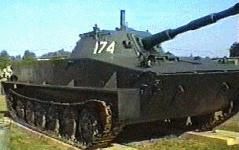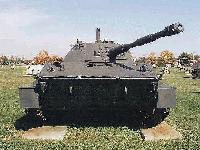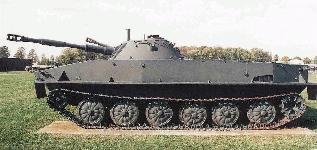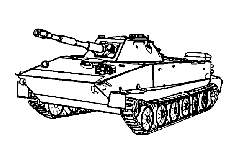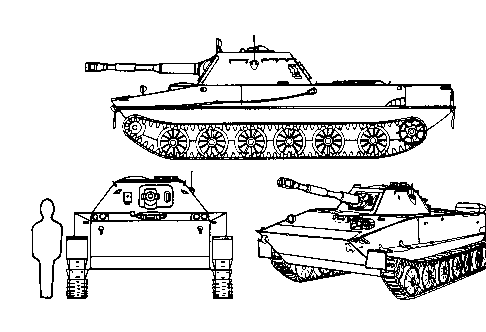
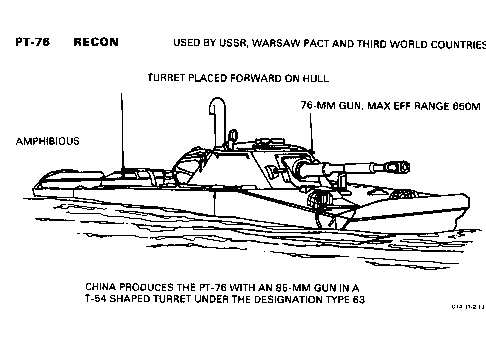




The PT-76 is a lightly armored amphibious tank with a flat, boat-like hull. The suspension has six road wheels and no return rollers. A dish-type turret is mounted over the second, third, and fourth road wheels, with a double hatch for commander and loader. The driver's hatch is located beneath the main gun, at the top of the sloping glacis plate.
The PT-76 was formerly the standard reconnaissance tank of the Soviet and Warsaw Pact armies. Although it has been replaced in first-line units by BMP-1 and BMP M1976 vehicles, it may still be found in the reconnaissance companies and battalions of some motorized rifle and tank regiments and divisions, as well as in naval infantry units. Aside from its reconnaissance role, it is also used for crossing water obstacles in the first wave of an attack and for artillery support during the establishment of a beachhead. Its V-6 240 hp water-cooled engine gives it a road speed of 44 km/hr with a cruising range of 260 km, and a twin waterjet propulsion system moves it through water at 10 km/hr with a range of 100 km. The 76-mm main gun, considered light for a modern tank, fires HVAP and HEAT rounds capable of penetrating APCs and other light armored vehicles. The PT-76 is a reliable, highly mobile reconnaissance vehicle and has ideal design for amphibious capability, but it has many limitations as a fighting vehicle.
Like most Soviet tanks, the PT-76 has limited ability to depress its main gun, and therefore cannot fire effectively from defilade. Its amphibious design makes it unnecessarily large for its weight class and allows less armor protection than in other light tanks. Because of its relatively thin armor (maximum thickness 14 mm in the hull, 17 mm in the turret), it is vulnerable to artillery fragments and .50 caliber machine gun fire. The fact that the commander is also the gunner and radio operator reduces his effectiveness as an observer. The PT-76 also lagged behind other Soviet armored fighting vehicles in having no night vision equipment and no NBC protection system for the three-man crew.
Four variants are distinguished by differences in the 76-mm main armament. Early models mounted a D-56T gun with no bore evacuator and a long, multi-slotted muzzle brake. Later models mount a D-56TM gun with a bore evacuator and a double-baffle muzzle brake. There are further variants with a stabilized D-56TM gun (PT-76B) and with an unidentified clean-barrel gun. A coaxial 7.62-mm machine gun is also mounted at the right of the main gun. The original PT-76 was produced in limited numbers with a non-stabilized main gun. Some PT-76s are augmented with 12.7-mm AA MGs.
The popular PT-76 chassis has also been modified for use in many subsequently developed vehicles, including the BTR-50P and OT-62 series of APCs, the ZSU-23-4 self-propelled antiaircraft gun, the ASU-85 airborne assault gun, the transport-launching vehicles for the FROG-2 through FROG-5 and SA-6/GAINFUL missiles, and even the BMP which replaced the PT-76 in Soviet reconnaissance units.
Specifications | |
| Alternative Designations | INA |
| Date of Introduction | 1952 |
| Proliferation | At least 21 countries |
| Description | |
| Crew | 3 |
| Combat Weight (mt) | 14.0 |
| Chassis Length Overall (m) | 6.91 |
| Height Overall (m) | 2.26 |
| Width Overall (m) | 3.14 |
| Ground Pressure (kg/cm 2 ) | 0.46 |
| Automotive Performance | |
| Engine Type | 240-hp Diesel |
| Cruising Range (km) | 260 |
| Speed (km/h) | |
| Max Road | 44 |
| Max Off-Road | INA |
| Average Cross-Country | 25 |
| Max Swim | 10 |
| Fording Depth (m) | Amphibious |
| Radio | R-123 |
| Protection | |
| Armor, Turret Front (mm) | 20 |
| Applique Armor (mm) | N/A |
| Explosive Reactive Armor (mm) | N/A |
| Active Protective System | N/A |
| Mineclearing Equipment | N/A |
| Self-Entrenching Blade | N/A |
| NBC Protection System | N/A |
| Smoke Equipment | VEESS |
| ARMAMENT | |
| Main Armament | |
| Caliber, Type, Name | 76-mm rifled gun D-56B |
| Rate of Fire (rd/min) | 6-8 |
| Loader Type | Manual |
| Ready/Stowed Rounds | INA |
| Elevation (�) | -4/+30 |
| Fire on Move | Yes |
| Auxiliary Weapon | |
| Caliber, Type, Name | 7.62-mm (7.62x54R) machinegun PKT |
| Mount Type | Coax |
| Maximum Aimed Range (m) | 1,500 |
| Max Effective Range (m) | |
| Day | 1,000/400-500 on the move |
| Night | 600 |
| Fire on Move | Yes |
| Rate of Fire (rd/min) | 250 practical / 650 cyclic, 2-10 round bursts |
| FIRE CONTROL | |
| FCS Name | INA |
| Main Gun Stabilization | 2-plane |
| Rangefinder | N/A |
| Infrared Searchlight | Available |
| Sights w/Magnification | |
| Gunner | TShK-66 |
| Day | |
| Field of View (�) | INA |
| Acquisition Range (m) | 4,000 |
| Night | TVN-28 IR Available |
| Field of View (�) | INA |
| Acquisition Range (m) | 600 |
| Commander Fire Main Gun | No |
| MAIN ARMAMENT AMMUNITION | |
| Caliber, Type, Name | |
| 76-mm HVAP-T, BM-354P | |
| Maximum Aimed Range (m) | 1,060 |
| Max Effective Range (m) | |
| Day | 650 |
| Night | 600 |
| Armor Penetration (mm) | 127 at muzzle, 50 at 1,000 m |
| 76-mm HEAT, BK-350M | |
| Maximum Aimed Range (m) | 1,000 |
| Max Effective Range (m) | |
| Day | 650 |
| Night | 600 |
| Armor Penetration (mm) | 280 to max range |
| 76-mm, Frag-HE, OF-350 | |
| Maximum Aimed Range (m) | 4,000 |
| Max Effective Range (m) | |
| Day | INA |
| Night | 600 |
| Armor Penetration (mm) | INA |
| Other Ammunition Types | 76-mm AP-T, BR-350 API-T |


